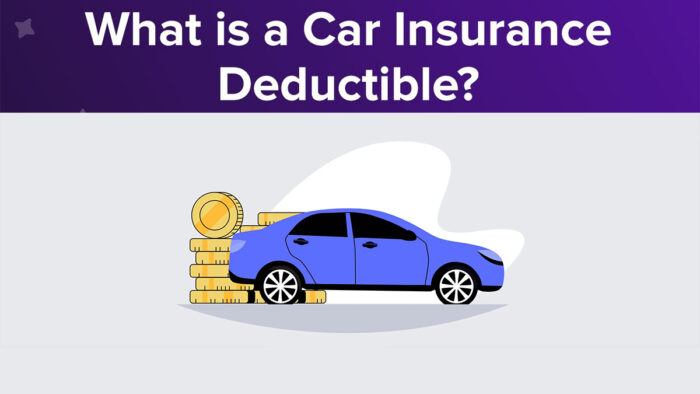A car insurance deductible is the sum subtracted from your claim when utilizing coverage like comprehensive or any insurance coverage. For instance, if you have experienced car damage, being battered by hail, or requiring repairs, you would submit a claim to your insurer, especially if you have comprehensive coverage.

Before the insurance company covers the cost of fixing the hail damage, your deductible is taken out of the claim check. Normally, car insurance deductibles are set at a fixed amount, like $500 or $1,000.
Deductibles are applicable to collision and comprehensive coverage in your auto policy. When filing specific claim types with your car insurance provider, you are responsible for paying the deductible. It’s important to note that liability coverage does not entail a deductible.
Typically, you have the flexibility to select your deductible amount, and opting for higher deductibles can lead to lower premium costs. This allows you to customize your policy based on your preferences and budget.
How Does a Car Insurance Deductible Work?
When enrolling in a car insurance policy, your insurer prompts you to select a deductible amount for specific coverage types, like collision coverage. The standard deductible is $500, but options range from $0 to $2,000.
If you file a claim necessitating the deductible, you are responsible for paying that amount upfront before your insurer covers any damage costs. In instances where fault in an accident is under dispute, your insurer may seek reimbursement from the responsible driver for your car’s damage, including the deductible you paid.
If you share fault in an accident, only a portion of the deductible may be recoverable. In cases where your insurer successfully recovers all claim costs and you are not at fault, the deductible you paid is refunded.
In contrast to health insurance deductibles, which require you to reach a certain annual spending threshold before coverage begins, car insurance deductibles operate on an event basis. So, if you have multiple covered claims in a year, you will need to pay a deductible for each incident.
Types of Car Insurance Deductible
Furthermore, car insurance deductibles utilize coverage by reducing claims and every other insurance company’s coverage. However, it has various types of coverage, which are as follows:
• Collision Coverage
If your car or truck collides with another vehicle accidentally, collision coverage comes to aid the victim by repairing your damaged car or truck. However, it offers a wide range of coverage, from $200 to $1000.
• ComprehensiveCoverage
Comprehensive coverage aids customers in fixing automobiles that have been damaged by dangerous events such as theft, burglary, or sleet. In addition, the coverage amount offers a range from $50 to $1000.
• Personal Injury Protection (PIP)
This coverage assists policyholders to cover indemnity benefits and medical expenses for both you and the passengers, no matter the situation of the accident. However, you may take responsibility for some medical expenses even after they have been deducted.
• Uninsured Motorist Coverage
Uninsured Motorist Coverage offers assistance for policyholders to pay for damages if they collide with an uninsured motorist. In certain situations, it may have a smaller deductible than regular coverage and a penalty ranging from $150 to $500.
Notably, settlements for insurers do not cover the whole amount, depending on the provider or the auto insurance company. However, guaranteed auto protection insurance helps to cover the insurer’s settlement and may also request deductibles if necessary.
• Coverage Without Car Insurance Deductible
In most states, liability coverage is requested, as it offers coverage for injuries and personal property damage to a third party or organization involved in an accident. Typically, when you buy it, the insurer will get a notification to choose the particular amount of coverage needed.
However, liability coverage offers a maximum amount of coverage and will be delivered to the other party as a claim. It has no deductible, as it aims to cover injuries and automobile repairs for the other party.
In addition, there are other ways that coverage doesn’t require deductibles, like glass repair or replacement, a zero-deductible policy, and most often, uninsured motorist coverage. Also, you can select other coverage that doesn’t require deductibles, like roadside assistance or rental car reimbursement.
How Do Car Insurance Deductibles Impact Premiums?
A case study of average car insurance premiums has confirmed deductible levels of two types: higher deductibles and lower deductibles. Insurance policies charge most people a low price due to the fact that they use higher deductibles, making them spend more money on claims.
Notably, if an accident record or additional charges on your policy are noticed, it can lead to an increase in deductibles.
• HigherDeductibles
Selecting higher deductibles can result in an affordable auto insurance premium. Moreover, it’s crucial to decide if you can pay the deductible fees at a specific time without spending much money. However, it is also reasonable to select lower deductibles when having a higher premium.
• Lower Deductibles
This type of deductible simply means you don’t have to commit as much money if you are engaged in a collision or comprehensive claim. Furthermore, it is crucial to know that it also entices drivers to order more claims, which can increase your rates, especially if you have many incidents.
There are many choices when comparing deductible levels, and all that comes to mind is choosing the best one. However, it’s advisable to decide as you compare car insurance companies.
• Deduct Price for Car Insurance or Repairs
Car insurance with higher deductibles will result in a lower insurance premium, which can cost you and make you order a claim for vehicle damage. Certain claims might be lower and require you to pay the entire deductible fee, putting you at a loss.
For instance, if your vehicle hits a tree and you fix it for $350 plus your collision deductible fee of $1000, you will make payments with your own finances for all fixations. However, if you choose a lower deductible, you will have lower expenses if you order a claim, but your insurance rate will increase.
For instance, if your deductible fee is $100 and you are involved in an accident of $350 by backing into a tree, you will have to take responsibility for $100. In addition, your insurance will cover $250 of the vehicle damage.
It’s also possible that you might spend more while obtaining a lower deductible and end up not ordering a claim. This can result in a high risk for you and your insurer, even if you have insurance coverage.
How to Choose the Right Car Insurance Deductible
Choosing the right car insurance deductible depends on some factors like budgets, availability of file claims, and level of risk tolerance. However, it’s crucial to determine these factors when choosing an appropriate deductible.
Budget
A higher deductible can assist you if you need to lower your insurance premium. Moreover, it’s advisable to make sure you can easily afford the deductible in case of any serious event like accidents or thefts. Also, note that the annual payment depends on the premium deductibles you need to pay.
However, certain states require higher deductible fees from insurers in order to keep clean records of claims.
Risk Level
To consider choosing the right deductible, it’s important to determine the filing claims of everyone covered by your policy. Additionally, consider aspects such as coverage for driving experience, high car theft at the parking lot, and accidental damages by the weather.
However, if your risk is low, you probably haven’t filed a claim, there is no increased risk of vandalism and theft, or you don’t usually drive in traffic, you can choose a higher premium. With the help of a lower premium, you can save on your auto insurance.
Risk Tolerance
Your ability to tolerate risk is a key factor in determining your risk tolerance. However, it’s essential to choose a low deductible and a higher premium to be on the safe side. However, a higher deductible might be best for you if you think it’s going to be suitable for you.
Insurers in most states provide $500 as a deductible for coverage, unless a lower amount is required. However, lower deductibles offer higher premiums from insurers or various deductibles on optional coverage.
Conclusion
Deductibles are the basic form of any car insurance company. It is essential to put in place your deductible fee carefully, as it can alter the whole annual cost. It’s advisable to shop around and compare policies based on premium and deductible amounts.


